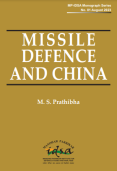Stress-Test for Chinese Restraint: China Evaluates Russia’s Use of Force
The article discusses if China will be inspired by its strategic partner Russia to use force as an instrument of its foreign policy. After a pro et con discussion the authors find that the disincentives created by the Russian example are likely to convince China that it should continue to show restraint under the ‘peaceful development’ formula, and avoid military adventures. The East Asian Peace is thus not seriously threatened, at least not by China—for now.
UNSC Resolution 2321 and the DPRK?
In a strong response to the nuclear warhead test of Pyongyang on September 9, 2016, the United Nations Security Council (UNSC) at its 7821st meeting, held on November 30, 2016, adopted Resolution 2321 (2016)—officially known as S/RES/2321—imposing fresh sanctions on the DPRK (Democratic People’s Republic of Korea). The Resolution specifically imposes restrictions on the DPRK’s exports that assist Pyongyang in generating revenue for its nuclear and ballistic missile programmes.
Japan’s Proactive Pacifism: Investing in Multilateralization and Omnidirectional Hedging
Since 2012, Japan’s foreign policy under Prime Minister (PM) Abe has been characterized as assertive, welcome or provocative. By employing the fear of abandonment/entrapment theory as the analytical framework, this article finds that Japan’s regional foreign policy under Abe is characterized by consolidation and investment in broad-based multilateralism, proactive engagement with partners in the region, including China, and strategic hedging.
China’s Naval Base(s) in the Indian Ocean—Signs of a Maritime Grand Strategy?
The article assesses China’s Indian Ocean strategy against the backdrop of its naval base development in Djibouti. It argues that China’s naval force posturing stems from a doctrinal shift to ocean-centric strategic thinking and is indicative of the larger gameplan of having a permanent naval presence in the Indian Ocean. China’s maritime strategy comprises four key components. First, to channel naval reinforcements for securing its maritime trade and economic interests in the Indian Ocean Region (IOR)—even as it strengthens the Maritime Silk Road initiative.
Israel–China Ties at 25: The Limited Partnership
Israel–China bilateral ties have witnessed significant growth since the establishment of full diplomatic relations in January, 1992. Both countries are currently investing their energies in realising the full potential of their on-going partnership in the innovation economy. Growing tourist linkages are another facet of the burgeoning relationship.
Korea’s Cultural Diplomacy: An Analysis of the Hallyu in India
Korea’s rapid economic transformation from being one of the poorest countries during the 1950s to becoming a member of the Organisation of Economic Co-operation and Development (OECD) in 1996 surprised the world, and is often considered the ‘Miracle on the Han River’. Within a period of a few decades, Korea became an economic powerhouse and one of the largest producers and exporters of steel, ships, automobiles, cell phones, etc. In recent years Hallyu or the ‘Korean Wave’ has taken the world by surprise.
Mass Media in Xi’s China: Markets Versus Control
Xi Jinping became the General Secretary of the Communist Party of China in November 2012 and the President of the People’s Republic of China in March 2013. Ever since, under his leadership as the Chinese President, the Chinese Communist Party (CCP) has been progressively tightening its control over the media. In a Communist structure, the media is perceived to be the ‘mouthpiece’ of the Party and is supposed to be used for propaganda. Media is a very essential tool in spreading the government agenda and controlling the public discourse.
Flimsy Reading of History Fails to Predict Tibet’s Future
Prof P. Stobdan (Senior Fellow, IDSA)’s reading of history fails to predict Tibet’s future from the beginning. The Dalai Lama has informed the Tibetan people about his thinking on the succession issue since as early as 1969. Later on September 24, 2011, the Dalai Lama took a definite position on the succession issue, where the Dalai Lama made it very clear that the decision to continue or not continue with the institution of the Dalai Lama lies with the Tibetan people. The real reason for ‘Younghusband’s visit’ to Tibet was not to lay a telegraph line.
The ASEAN Way of Conflict Management in the South China Sea
This article examines how the Association of Southeast Asian Nations (ASEAN) conflict management process in the South China Sea (SCS) has been conducted and whether the ASEAN way can effectively manage the dispute, in which China is a prime and important actor. It argues that rising tensions in the South China Sea are a direct result of the changed balance of power in the region given the asymmetry between China and ASEAN members. China has taken advantage of ASEAN efforts to develop a code of conduct that is premised on the ASEAN way.











